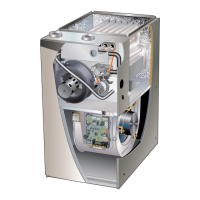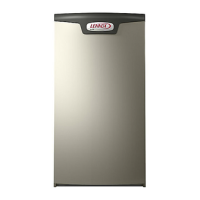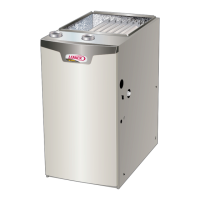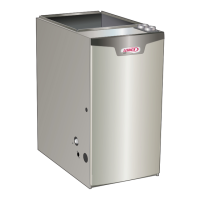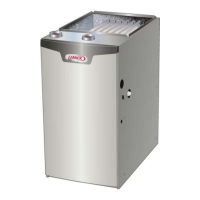Page 49
The controller uses sensing devices to sense what posi-
tion the rotor is in at any given time. By sensing the posi-
tion of the rotor and then switching the motor windings on
and o in sequence, the rotor shaft turns the blower.
All EL297UHNV blower motors use single phase power.
An external run capacitor is not used. The motor uses per-
manently lubricated ball-type bearings.
Internal Operation
The motor is controlled via serial communication between
the integrated control on the furnace and the controller
attached to the motor shell. The messages sent back and
forth between the two controls serve to communicate rota-
tional direction, demand, motor size, current draw, torque,
and rpm, among other variables.
Motor rpm is continually adjusted internally to maintain
constant static pressure against the blower wheel. The
controller monitors the static work load on the motor and
motor ampdraw to determine the amount of rpm adjust-
ment. Blower rpm may be adjusted any amount in order to
maintain a constant cfm as shown in Blower Ratings Ta-
bles. The cfm remains relatively stable over a broad range
of static pressure. Since the blower constantly adjusts rpm
to maintain a specied cfm, motor rpm is not rated. Hence,
the terms “cool speed”, “heat speed ” or “speed tap” in
this manual, on the unit wiring diagram and on blower B3,
refer to blower cfm regardless of motor rpm.
Initial Power Up
When line voltage is applied to B3, there will be a large
inrush of power lasting less than 1/4 second. This inrush
charges a bank of DC lter capacitors inside the controller.
If the disconnect switch is bounced when the disconnect is
closed, the disconnect contacts may become welded. Try
not to bounce the disconnect switch when applying power
to the unit.
Motor Start-Up
When B3 begins start-up, the motor gently vibrates back
and forth for a moment. This is normal. During this time
the electronic controller is determining the exact position
of the rotor.
Once the motor begins turning, the controller slowly eases
the motor up to speed (this is called “soft-start”). The mo-
tor may take as long as 10-15 seconds to reach full speed.
If the motor does not reach 200 rpm within 13 seconds,
the motor shuts down. Then the motor will immediately at-
tempt a restart. The shutdown feature provides protection
in case of a frozen bearing or blocked blower wheel. The
motor may attempt to start eight times. If the motor does
not start after the eighth try, the controller locks out. Reset
controller by momentarily turning o power to unit.
The DC lter capacitors inside the controller are connect-
ed electrically to the motor supply wires. The capacitors
take approximately 5 minutes to discharge when the dis-
connect is opened. For this reason it is necessary to wait
at least 5 minutes after turning o power to the unit before
attempting to service motor.
WARNING
Disconnect power from unit and wait at
least ve minutes to allow capacitors to
discharge before attempting to service
motor. Failure to wait may cause personal
injury or death.
Power Choke (L13)
A choke coil is used on EL297UHV 4 and 5 ton units
equipped with 1 hp motors. The choke is located on the
blower housing and is used to suppress transient current
spikes.
Troubleshooting Motor Operation
To verify motor operation see steps below and FIGURE 10
and FIGURE 11.
1 - Remove J48 (5 pin power plug) from P48 on the
motor.
2 - With the power on at the furnace and door switch
depressed, use a test meter to verify 120V between
pins 4 and 5 on J48.
3 - Reconnect J48 to P48 on the motor.
4 - Remove J49 (4 pin low voltage connector) from P49
on the motor.
5 - Using test jumpers, apply 24V to pins 3 and 4 on
P49 on the motor.
Note: Do not apply 24V to pins 2 and 4 on P49.
Doing so will cause permanent damage to the motor.
6 - Motor should run at 75%.
7 - Test is complete. Remove jumpers and reconnect
plugs.
Another option is to use the TECMate PRO motor tester
with the 16 to 4 pin adaptor. The use of the TECMate PRO
isolates the motor from the integrated control. Follow the
instructions provided with the kit. If the motor runs do not
replace.

